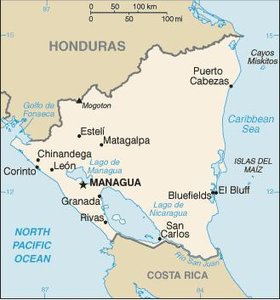Protected Areas of Nicaragua
|
Area |
| |
|
Total Area of nationally recognized protected areas (% of Nicaragua's Territorial Area) |
74 |
26,486 |
15.3% |
|
- Terrestrial (% of Nicaragua's Terrestrial Territorial Area) |
74 |
22,007 |
16.9% |
|
- Marine and Littoral Protected Area |
5 |
4,479 |
|
|
Note that some protected areas include both terrestrial area and marine area |
|||
|
Nationally recognized protected areas greater than 1,000 km2 |
4 |
||
|
Nationally recognized protected areas greater than 10,000 km2 |
0 |
||
|
Wetlands of International importance (Ramsar Sites) |
8 |
4,057 |
|
|
UNESCO-MAB Biosphere Reserves |
2 |
35,744 |
There are eight wetlands in Nicaragua recognized as important under the the Convention on Wetlands (Ramsar Convention):
| Cayos Miskitos y Franja Costera Immediata | Marine | 85,000 |
| Deltas del Estero Real y Llanos de Apacunca | Marine | 81,700 |
| Lago de Apanás-Asturias | Terrestrial | 5,415 |
| Los Guatusos | Terrestrial | 43,750 |
| Refugio de Vida Silvestre Río San Juan | Marine | 43,000 |
| Sistema de Humedales de la Bahía de Bluefields | Marine | 86,501 |
| Sistema de Humedales de San Miguelito | Terrestrial | 43,475 |
| Sistema Lagunar de Tisma | Terrestrial | 16,850
|
There are two UNESCO-MAB Biosphere Reserves in Nicaragua
- Bosawas Biosphere Reserve 2,181,500 hectares (UNESCO-MAB Biosphere Reserve)
- Rio San Juan Biosphere Reserve 1,392,900
The latest World database on Protected Areas identifies 93 protected areas in Nicaragua (19 more than the summary above):
National Parks:
- Archipiélago de Zapatera 5,227 hectares
- Saslaya National Park 27,792 hectares
- Volcán Masaya National Park 4,745 hectares
National Monuments:
- Archipiélago de Solentiname National Monument 18,930 hectares
Nature Reserves:
- Alamikamba Nature Reserve 2,100 hectares.
- Cabo Viejo Nature Reserve 5,800 hectares
- Cerro Apante Nature Reserve 1,230 hectares
- Cerro Cola Blanca Nature 22,200 hectares
- Cerro Cumaica - Cerro Alegre Nature Reserve 5,115 hectares
- Cerro El Arenal Nature Reserve 649 hectares</span>
- Cerro Guabule Nature Reserve 5,485 hectares</span>
- Cerro Kilambé Nature Reserve 11,440 hectares
- Cerro Mombachito - La Vieja Nature Reserve 809 hectares
- Cerro Musún Nature Reserve 4,700 hectares
- Cerro Pancasan Nature Reserve 180 hectares
- Cerro Quiabuc (Las Brisas) Nature Reserve 3,179 hectares
- Cerro Tisey - Estanzuela Nature Reserve 6,142 hectares
- Cerros de Bana Cruz Nature Reserve 24,767 hectares
- Complejo Volcánico Momotombo y Momotombito Nature Reserve 9,182 hectares
- Complejo Volcánico Pilas - El Hoyo Nature Reserve 8,365 hectares
- Complejo Volcánico San Cristóbal - Casita Nature Reserve 18,294 hectares
- Complejo Volcánico Telica - Rota Nature Reserve 10,209 hectares
- Cordillera Dipilto y Jalapa Nature Reserve 27,239 hectares
- Cordillera Yolaina Nature Reserve 30,160 hectares
- Estero Padre Ramos Nature Reserve 9,688 hectares
- Estero Real Nature Reserve 74,822 hectares
- Fila Cerro Frío - La Cumplida Nature Reserve 2,479 hectares
- Fila Masigüe Nature Reserve 5,529 hectares
- Isla Juan Venado Nature Reserve 7,074 hectares
- Kligna Nature Reserve 3,831 hectares
- Kuskawas Nature Reserve 5,155 hectares
- Laguna de Apoyo Nature Reserve 3,306 hectares
- Laguna de Asososca Nature Reserve 118
- Laguna de Nejapa Nature Reserve 188 hectares
- Laguna de Tiscapa Nature Reserve 125 hectares
- Laguna de Tisma Nature Reserve 6,321
- Laguna Kukalaya Nature Reserve 4,273 hectares
- Laguna Layasica Nature Reserve 4,895 hectares
- Laguna Pahara Nature Reserve 10,874 hectares
- Laguna Tala - Sulama Nature Reserve 36,812 hectares
- Laguna Yulu-Karata Nature Reserve 27,414 hectares
- Lagunas Bismuna T.Raya - Leimus Nature Reserve 10,546 hectares
- Limbaika Nature Reserve 1,709 hectares
- Llanos de Karawala Nature Reserve 2,694 hectares
- Llanos de Makantaka Nature Reserve 1,686
- Macizo de Peñas Blancas Nature Reserve 12,761 hectares
- Mesa de Moropotente Nature Reserve 8,344 hectares
- Península de Chiltepe Nature Reserve 3,981 hectares
- Ramal de Datanli - Cerro El Diablo Nature Reserve 2,217 hectares
- Río Manares Nature Reserve 1,075 hectares
- Salto del Río Yasica Nature Reserve 224 hectares
- Sierra Amerrisque Nature Reserve 15,912 hectares
- Sierra Kiragua Nature Reserve 11,413 hectares
- Sistema Lagunar de Mecatepe Nature Reserve 901 hectares
- Tepesomoto / Pataste Nature Reserve 9,168 hectares
- Volcán Concepción Nature Reserve 3,113 hectares
- Volcán Cosigüina Nature Reserve 12,137 hectares
- Volcán Madera Nature Reserve 5,384 hectares
- Volcán Mombacho Nature Reserve 1,240 hectares
- Volcán Yalí Nature Reserve 3,637 hectares
- Yulu Nature Reserve 3,997 hectares
Natural Resources Reserves:
- Bosawas National Resource/s Reserve 730,000 hectares
Forest Reserves:
- Cerro Silva Forest Reserve 260,277 hectares
- Cerro Wawashan Forest Reserve 2,207 hectares
Marine Reserves:
- Cayos Miskitos Marine Reserve 12,667 hectares
Wildlife Refuges:
- Los Guatuzos Wildlife Refuge 42,784 hectares
- Río Escalante-Chococente Wildlife Refuge 5,009 hectares
Other Reserves:
- Río Indio Maíz Biological Reserve 413,901 hectares
- Yucul Genetic Reserve 4,686 hectares
Historic Monuments:
- Fortaleza la Inmaculada Historic Monument 3,208
Other areas:
- Apanás
- Cayos Perlas
- Delta Del Estero Real
- Desembocadura del Río Escondido
- Desembocadura del Río Grande de Matagalpa
- Desembocadura del Río ejo
- Ensenada El Pato
- Estero El Junquillo
- Estero Las Marías
- Isla Nancital
- Islas Maderas Negras
- La Máquina (Private Reserve)
- Laguna Baka Day
- Laguna de Moyuá
- Laguna Grande
- Laguna Lawira
- Laguna Perlas (abajo) Ñocarime
- Río Kuanwatla
- Río Punta Gorda
- Rio San Juan
- Saslaya
Return to Protected Area Collection for Latin America and the Caribbean
Return to the Latin America and the Caribbean Collection
Further Reading:
- World Resources Institute(accessd May 26, 2009)
- World Database on Protected Areas (accessed May 26, 2009)
